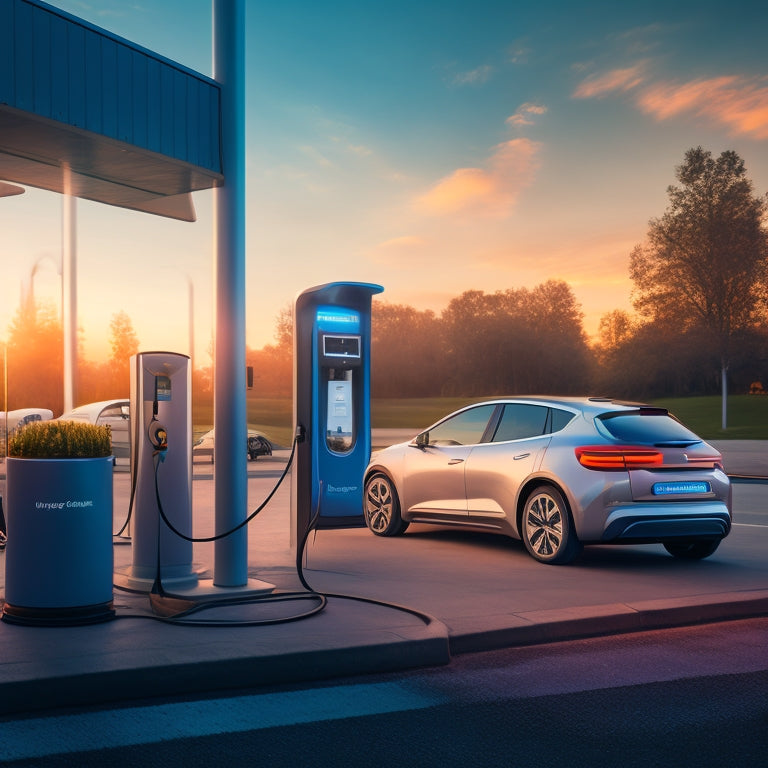
Fleet Charging Station Inspection Checklist Essentials
Share
When inspecting your fleet charging station, you'll need to prioritize key components to guarantee efficient and safe operation. Start by monitoring solar panel performance, verifying electrical connections and wiring, and maintaining clean panels through effective debris removal methods. Don't forget to inspect inverters and trackers, verify grounding and bonding connections, and examine overcurrent protection devices. Additionally, assess environmental and physical damage risks, and review system performance data to identify trends and anomalies. By following these essential checklist items, you'll be well on your way to optimizing your station's performance - and there's even more to discover.
Key Takeaways
• Verify electrical connections, wiring, and components for safety and efficiency.
• Inspect and clean solar panels regularly to prevent debris buildup and ensure optimal energy output.
• Perform routine checks on inverters, trackers, and overcurrent protection devices to ensure reliable operation.
• Conduct weather resistance testing and corrosion risk assessments to prevent environmental damage.
• Analyze system performance data to identify trends, anomalies, and areas for optimization and corrective action.
Solar Panel Performance Monitoring
You'll want to verify that the solar panel performance monitoring system is accurately tracking key performance indicators, including energy output, temperature, and voltage, to guarantee peak fleet charging station efficiency. This monitoring system is essential for optimizing energy efficiency, as it enables you to identify areas of improvement and make data-driven decisions.
By leveraging advanced data analytics, you can analyze the performance data and pinpoint potential issues, such as underperforming panels or inefficient energy conversion. This proactive approach ensures that your fleet charging station operates at maximum capacity, minimizing energy waste and reducing costs.
Electrical Connections and Wiring
During the inspection, confirm that all electrical connections and wiring are securely fastened, properly sized, and meet the required safety standards to guarantee the fleet charging station operates safely and efficiently.
You should verify that all cables are properly routed, secured, and protected from damage. Verify that wire labeling is accurate and consistent, making it easy to identify and troubleshoot issues. Proper cable management is vital to prevent overheating, electrical shock, and fires.
Check for signs of wear, corrosion, or damage on connections, wires, and terminals. Confirm that all electrical components are rated for the specified voltage and current.
Panel Cleaning and Debris Removal
When inspecting your fleet charging station, you'll want to make sure that panels are clean and free from debris to maintain peak performance.
You'll need to choose the right cleaning tools and methods to remove dirt, dust, and other obstructions that can compromise electrical connections.
Debris Removal Methods
Your fleet charging station's electrical panels require regular cleaning to guarantee peak performance, and employing effective debris removal methods is essential to preventing damage from dust, dirt, and other contaminants. Debris categorization is vital in determining the best removal approach.
You'll need to identify the type of debris, whether it's dry dust, sticky spills, or corrosive substances. Automated sweeping is a reliable method for removing loose particles, but more stubborn contaminants may require manual intervention.
Panel Cleaning Tools
Equipped with the right panel cleaning tools, you can efficiently remove debris and contaminants from your fleet charging station's electrical panels, guaranteeing peak performance and reliability. Having the correct tools at your disposal saves time and guarantees a thorough cleaning process.
Here are the essential panel cleaning tools you should have:
-
Water jets: For gentle yet effective removal of dirt and grime.
-
Brush handles: With soft-bristled brushes for delicate surfaces and stiff-bristled brushes for more stubborn debris.
-
Microfiber cloths: For wiping down surfaces and absorbing any remaining moisture.
With these tools, you'll be well-equipped to tackle even the toughest panel cleaning tasks, ensuring your fleet charging station operates at top levels.
Regular Maintenance Schedule
By establishing a regular maintenance schedule, you'll prevent debris buildup and guarantee your fleet charging station's electrical panels remain clean and functional. This schedule secures that your charging station operates efficiently and safely.
To achieve this, you should define a schedule frequency that suits your station's usage and environmental conditions.
Maintenance Cycles:
- Daily Inspection: Check for visible debris and dust
- Weekly Cleaning: Clean electrical panels and surrounding areas
- Monthly Deep Cleaning: Perform thorough cleaning of all electrical components
Inverter and Tracker Inspection
During the inspection, you'll examine the inverter and tracker systems, which are critical components in guaranteeing the reliable and efficient operation of your fleet charging station.
Here are the key areas to focus on during the inverter and tracker inspection:
-
Inverter efficiency: Verify that the inverter is operating within the recommended efficiency range to minimize energy losses and ensure peak charging performance.
-
Tracker alignment: Check that the trackers are properly aligned to maximize energy harvesting and prevent damage to the system.
-
System monitoring: Review the inverter and tracker system monitoring data to identify any performance issues or anomalies that require attention.
Grounding and Bonding Verification
You'll need to verify that the grounding and bonding systems are properly installed and maintained to guarantee the safe and reliable operation of your fleet charging station. This is critical for electrical safety, as improper grounding and bonding can lead to electrical shock, fires, and even fatalities.
During the inspection, check that all grounding and bonding connections are secure, clean, and free of corrosion. Verify that the grounding system is properly sized and rated for the electrical load. Perform fault detection tests to ensure the system can detect and respond to ground faults.
Overcurrent Protection Devices
As you inspect the fleet charging station, make sure to examine the overcurrent protection devices, which are essential for preventing electrical overloads that can cause damage to equipment and pose a fire hazard. These devices are vital in ensuring the safe and reliable operation of your fleet charging station.
When inspecting overcurrent protection devices, check the following:
-
Circuit Breaker: Verify that the circuit breaker is functioning correctly and not tripping unnecessarily.
-
Arc Fault: Ensure that the arc fault protection devices are installed and functioning as intended to prevent electrical arcing.
-
Trip Settings: Verify that the trip settings are configured correctly to prevent electrical overloads.
Environmental and Physical Damage
As you inspect the fleet charging station, you'll need to assess the environmental and physical damage risks that can compromise the station's integrity.
You'll want to evaluate the site's conditions, checking for signs of corrosion and weathering that could weaken the charging infrastructure.
Weather Resistance Testing
During the weather resistance testing phase, your team must simulate environmental stressors to evaluate the fleet charging station's durability against physical damage and harsh weather conditions. This involves implementing weather testing protocols that mimic real-world scenarios, such as extreme temperatures, humidity, and precipitation.
To guarantee thorough testing, focus on the following key areas:
-
Climate simulation methods: Utilize advanced climate simulation chambers or outdoor testing facilities to replicate diverse environmental conditions.
-
Weathering tests: Expose the charging station to accelerated weathering cycles, including UV radiation, salt spray, and freeze-thaw testing.
-
Physical damage assessments: Conduct impact resistance tests to evaluate the station's durability against vandalism, accidents, or natural disasters.
Corrosion Risk Assessment
After simulating environmental stressors, you'll need to assess the fleet charging station's vulnerability to corrosion, which can be exacerbated by physical damage and harsh environmental conditions.
As you inspect the station, pay attention to areas prone to moisture accumulation, such as cable entry points and electrical enclosures. Coastal exposure is a significant corrosion risk factor, so consider the station's proximity to the coast and the resulting salt air exposure.
Evaluate the material selection used in the station's construction, ensuring that materials are resistant to corrosion and suitable for the local environment. Look for signs of corrosion, such as rust or flaking paint, and identify potential areas of water ingress.
Site Condition Evaluation
Evaluate the site's condition by examining the surrounding environment and physical infrastructure for signs of damage, wear, and tear, which can impact the fleet charging station's performance and longevity. You'll want to identify any potential hazards that could compromise the station's operation or safety.
When evaluating the site, consider the following factors:
-
Accessibility concerns: Are there any obstacles or barriers that could limit access to the charging station, such as steep slopes or narrow pathways?
-
Geological surveys: Have there been any recent geological surveys or assessments conducted to identify potential risks, such as soil instability or flood zones?
-
Physical damage: Are there any signs of physical damage, such as cracks in the pavement or damaged signage, that could impact the station's functionality?
System Performance Data Review
You'll review system performance data to identify trends, anomalies, and areas for improvement in the fleet charging station's operation. This review is essential to guarantee the station is running efficiently and effectively.
You'll analyze data analytics to assess performance metrics such as charging times, energy consumption, and equipment utilization. By examining these metrics, you'll pinpoint potential issues, like underperforming chargers or inefficient energy distribution.
This analysis will enable you to optimize the system's configuration, adjust operational parameters, and implement corrective actions. By doing so, you'll maximize the station's capacity, reduce downtime, and improve overall system reliability.
Frequently Asked Questions
Can Fleet Charging Stations Be Customized for Specific Vehicle Types?
Did you know that 80% of fleets prioritize vehicle compatibility when selecting charging stations? You can customize fleet charging stations for specific vehicle types, optimizing charging for your unique fleet needs, ensuring seamless vehicle compatibility and charging optimization.
How Often Should Charging Station Inspections Be Performed?
You should conduct charging station inspections at regular intervals, ideally every 3-6 months, to guarantee peak performance and identify potential issues before they become major problems, allowing you to schedule maintenance and minimize downtime.
Are There Any Specific Certifications Required for Inspectors?
'Cut to the chase' - you need inspectors who are certified to guarantee a thorough job. Look for inspectors with training from reputable organizations, adhering to strict certification standards, ensuring competence in inspecting your fleet's charging stations.
Can Fleet Charging Stations Be Integrated With Existing Infrastructure?
You can integrate fleet charging stations with existing infrastructure, leveraging an infrastructure upgrade to enhance energy efficiency, and optimize your station's performance, ensuring a seamless and sustainable charging experience.
What Is the Average Cost of a Fleet Charging Station Inspection?
'You're likely to spend around $500 to $2,000 per inspection, depending on the station's complexity, with a national average of $1,200. Conduct a thorough cost analysis and budget planning to guarantee seamless fleet operations and minimize downtime.'
Related Posts
-

Why Choose Cool Roofs in Scorching Climates?
You opt for cool roofs in scorching climates because they enable you to reclaim control over your energy consumption ...
-

Why Choose Solar Composting Toilets for Your Home?
By choosing a solar composting toilet for your home, you'll greatly reduce your environmental impact, slashing your w...
-

7 Smart Air Purification Hacks for Energy-Savvy Homes
You can notably improve your indoor air quality while minimizing energy consumption by implementing strategic air pur...


